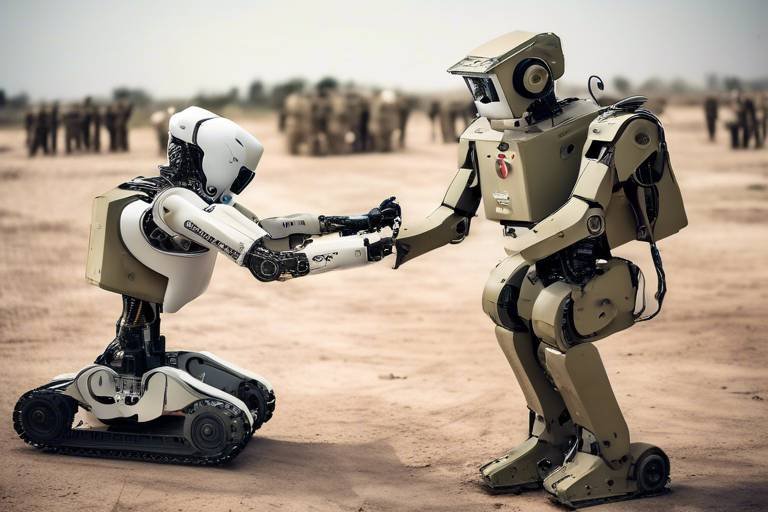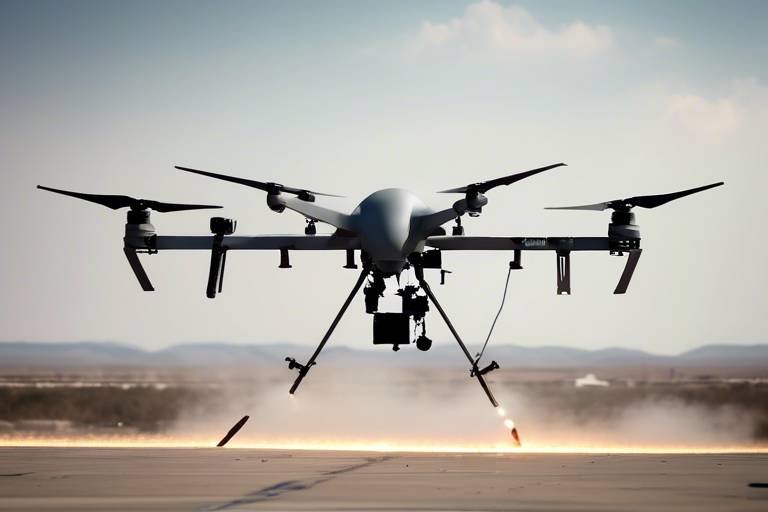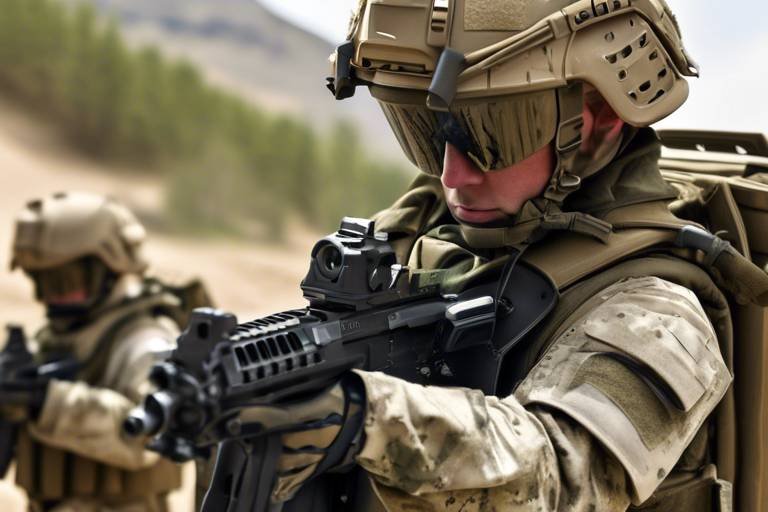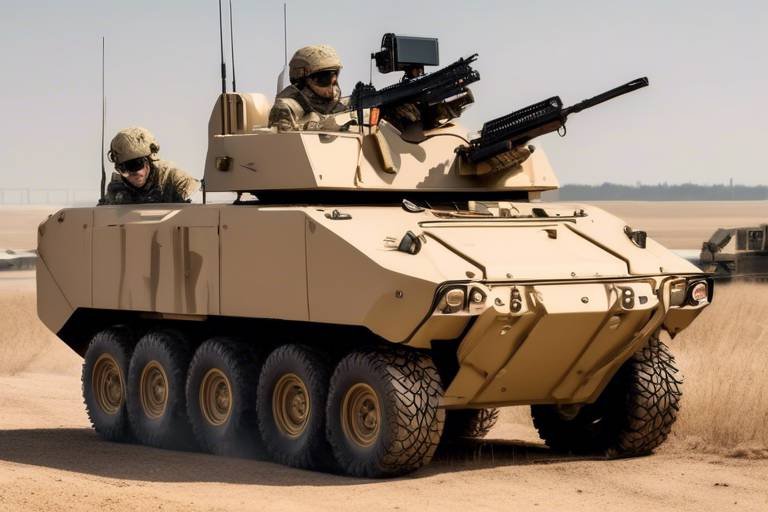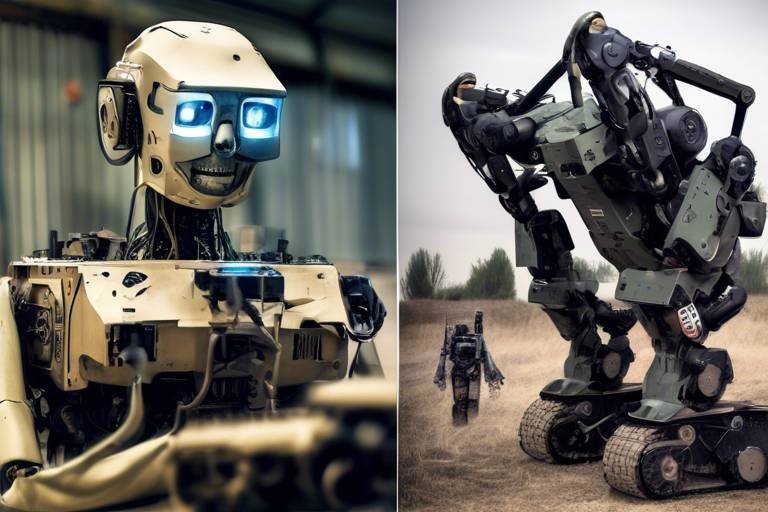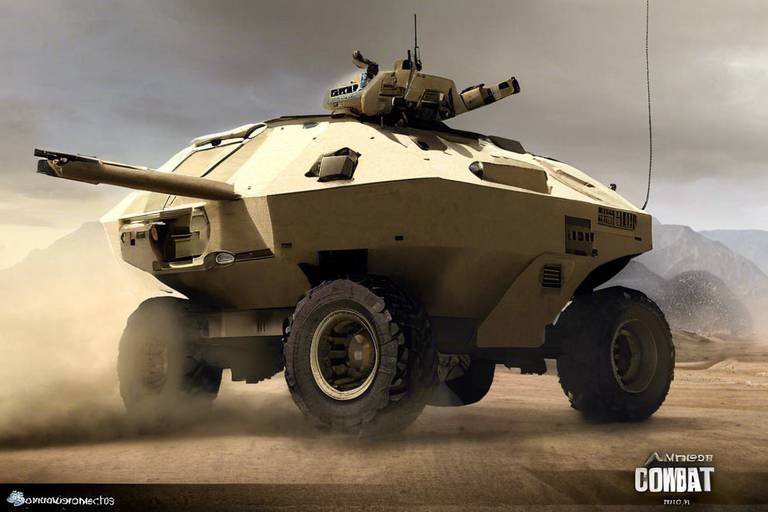The Role of Robotics in Military Humanitarian Operations
The integration of robotics into military humanitarian operations is not just a trend; it’s a transformative leap that redefines how we respond to crises. Imagine a world where robots are the first responders, navigating treacherous terrains and delivering aid where human beings cannot easily reach. This is not science fiction; it’s happening now. Robotics has become a vital tool in military-led humanitarian missions, enhancing both efficiency and safety. But what does this really mean for disaster response and recovery? Let’s dive deeper into the remarkable world of robotics in humanitarian aid.
At its core, the use of robotics in military humanitarian operations revolves around the idea of leveraging technology to save lives. From drones soaring high above disaster zones to ground robots braving hazardous environments, these machines are designed to operate in conditions that would be perilous for human rescuers. The military's involvement adds a layer of organization and resource allocation that is crucial during crises. The goal is simple: to provide timely assistance and facilitate recovery efforts in the most effective way possible.
Robotics not only enhances operational capabilities but also reduces the risk to human life. In scenarios where traditional methods may fail or be too dangerous, robots can step in to perform critical tasks. They can survey damage, locate survivors, and even deliver supplies—all while keeping human responders out of harm’s way. This innovative approach is revolutionizing the way we think about disaster management and humanitarian aid.
Moreover, the collaboration between military forces and technological advancements opens up exciting possibilities. With the integration of artificial intelligence and machine learning, these robotic systems are becoming smarter and more autonomous. They can analyze data in real-time, adapt to changing environments, and make decisions that enhance their operational effectiveness. This is particularly important in chaotic disaster scenarios where every second counts.
However, the journey of integrating robotics into military humanitarian operations is not without its challenges. There are technical limitations to overcome, ethical considerations to address, and operational hurdles to navigate. As we explore the various types of robots used in these missions, we must also acknowledge the complexities that come with their deployment. Understanding both the potential and the pitfalls is crucial for harnessing the full power of robotics in humanitarian efforts.
- What types of robots are commonly used in military humanitarian operations?
Various types include drones for aerial surveillance, ground robots for search and rescue, and underwater robots for exploring flooded areas. - How do drones assist in disaster relief?
Drones provide aerial surveillance, deliver medical supplies, and help assess damage in real-time, making them invaluable in crisis situations. - What are the ethical concerns regarding the use of robots in humanitarian efforts?
Ethical concerns include the autonomy of robots in decision-making and the need for guidelines to ensure responsible deployment in sensitive situations. - Can robots operate in all types of environments?
While robots are designed to navigate various terrains, limitations such as battery life and adaptability to extreme conditions can pose challenges.

Introduction to Robotics in Humanitarian Aid
Robotics has become a game-changer in the realm of humanitarian operations, particularly when it comes to military-led missions. Imagine a world where robots can navigate the most treacherous terrains, assess damage from the sky, and deliver life-saving supplies to those in desperate need. This is not science fiction; it is the reality we are stepping into. The integration of robotics into humanitarian efforts enhances both efficiency and safety, allowing humanitarians to focus on what matters most—saving lives.
At the heart of this transformation are various technologies that empower robots to perform complex tasks. From drones flying overhead to ground vehicles maneuvering through debris, these machines are designed to operate in environments that are often too dangerous for humans. For instance, during a natural disaster, traditional methods of delivering aid can be hampered by blocked roads and hazardous conditions. Here, robotics steps in as a reliable alternative, providing a way to reach affected populations quickly and effectively.
The use of robotics in humanitarian aid is not just about replacing human efforts; it’s about enhancing them. Robots can collect data, monitor situations in real-time, and even assist in search and rescue operations. They can traverse areas that are perilous for human responders, thus minimizing risk while maximizing the impact of aid efforts. However, the journey to fully integrating robotics into humanitarian missions is not without its challenges. It involves navigating a landscape filled with technical, ethical, and operational hurdles.
To give you a clearer picture, let’s break down some of the key technologies involved in this robotic revolution:
| Type of Robot | Primary Function | Benefits |
|---|---|---|
| Drones | Aerial Surveillance and Delivery | Quick access to hard-to-reach areas |
| Ground Robots | Search and Rescue Operations | Enhanced safety in hazardous environments |
| Underwater Robots | Disaster Recovery in Flooded Areas | Ability to operate in submerged conditions |
As we delve deeper into the role of robotics in military humanitarian operations, it becomes evident that these technologies are not just tools; they are vital partners in our quest to provide aid. They open up new possibilities for disaster response and recovery, ensuring that help reaches those who need it most, regardless of the circumstances. With this exciting potential comes a responsibility to address the challenges that accompany the deployment of such advanced technologies.
In the following sections, we will explore the various types of robotics used in humanitarian operations, the specific challenges faced in their implementation, and the ethical considerations that must be taken into account to ensure their responsible use. Stay tuned as we uncover the fascinating world of robotics in humanitarian aid!
- What types of robots are commonly used in humanitarian aid? Drones, ground robots, and underwater robots are some of the most common types.
- How do drones assist in disaster relief? Drones provide aerial surveillance, deliver supplies, and assess damage in real-time.
- What are the main challenges of using robotics in humanitarian operations? Challenges include technical limitations, ethical considerations, and operational hurdles.
- Can robots replace human responders in humanitarian efforts? While robots enhance efficiency and safety, they are designed to assist rather than replace human efforts.

Types of Robotics Used in Humanitarian Operations
In the ever-evolving landscape of humanitarian aid, the integration of robotics has emerged as a game-changer. Various types of robots are utilized to enhance efficiency, safety, and effectiveness in military-led humanitarian missions. These robots can be broadly categorized into three main types: drones, ground vehicles, and underwater robots. Each of these categories brings unique capabilities to the table, making them indispensable in different operational scenarios.
Drones are perhaps the most recognized type of robotics in humanitarian efforts. They soar above disaster-stricken areas, providing crucial aerial surveillance that helps organizations understand the extent of damage and the needs of affected populations. With their ability to cover vast areas quickly, drones can map affected regions, assess damage, and even deliver supplies to remote locations that are otherwise inaccessible. This rapid response capability is vital in scenarios where every second counts.
Ground robots are another essential component of humanitarian operations. Designed to navigate hazardous environments, these robots can perform search and rescue missions in disaster-stricken areas. Imagine a scene where a building has collapsed, and survivors are trapped beneath the rubble. Ground robots, equipped with advanced sensors and cameras, can maneuver through debris, locate survivors, and relay vital information back to rescue teams. Their ability to operate in challenging terrains not only enhances the chances of finding survivors but also keeps human rescuers safe from potential dangers.
Finally, we have underwater robots, which are particularly useful in disaster scenarios involving flooding or maritime accidents. These robots can explore submerged areas, assess damage to infrastructure, and even locate missing persons in aquatic environments. Their specialized design allows them to operate efficiently in conditions that would be hazardous for human divers. By leveraging these underwater robots, humanitarian teams can gather crucial information that aids in recovery efforts.
In summary, the types of robotics used in humanitarian operations are diverse and tailored to meet the specific challenges posed by various disaster scenarios. The integration of drones, ground vehicles, and underwater robots not only enhances operational efficiency but also significantly improves the safety of both rescuers and those in need. As technology continues to advance, we can expect to see even more innovative solutions that will further revolutionize the way humanitarian aid is delivered.
- What are the main types of robots used in humanitarian operations?
The main types include drones, ground vehicles, and underwater robots, each serving unique functions in disaster response. - How do drones assist in humanitarian efforts?
Drones provide aerial surveillance, mapping affected areas, and delivering supplies to remote locations quickly and efficiently. - What challenges do ground robots face in disaster scenarios?
Ground robots must navigate hazardous environments, which can include unstable debris and varying terrain, posing technical challenges. - Are there ethical concerns regarding the use of robotics in humanitarian operations?
Yes, ethical considerations include issues of autonomy, decision-making, and ensuring responsible use of technology in sensitive contexts.

Drones for Aerial Surveillance
Drones have revolutionized the way we approach disaster response and humanitarian aid. Imagine being able to fly over a disaster-stricken area and gather crucial information in real-time without putting human lives at risk. This is precisely what drones enable us to do. Equipped with high-resolution cameras and advanced sensors, these aerial vehicles can provide detailed maps of affected regions, allowing military and humanitarian teams to assess the situation quickly and accurately.
One of the standout features of drones is their ability to cover vast areas in a short amount of time. Traditional methods of surveying disaster zones often involve ground vehicles or helicopters, which can be slow and risky. In contrast, drones can be deployed rapidly and can access areas that might be dangerous or impossible for humans to reach. This capability is particularly vital in the aftermath of natural disasters, where roads may be blocked, and conditions can be hazardous.
Moreover, drones facilitate the collection of real-time data that is essential for effective decision-making. By utilizing thermal imaging and infrared technology, drones can identify heat signatures from survivors trapped under rubble or in remote locations. This information can be invaluable for search and rescue operations. Furthermore, the data collected can be used to create detailed maps that help responders prioritize their efforts and allocate resources more effectively.
In addition to their surveillance capabilities, drones can also assist in logistics by delivering supplies to isolated areas. For instance, in regions where traditional transport routes are compromised, drones can fly in medical supplies, food, and water, ensuring that those in need receive assistance promptly. This dual functionality of surveillance and delivery makes drones a critical asset in military humanitarian operations.
However, the integration of drones into humanitarian efforts does not come without its challenges. Issues such as regulatory hurdles, privacy concerns, and the need for trained personnel to operate these devices must be addressed. As we move forward, it will be crucial to develop comprehensive guidelines that ensure the responsible use of drones in humanitarian contexts.
- What types of drones are used for aerial surveillance?
There are various types of drones, including fixed-wing and multi-rotor drones, each suited for different surveillance tasks depending on the operational requirements. - How do drones improve disaster response times?
Drones can be deployed quickly and cover large areas rapidly, allowing for faster assessments and more efficient resource allocation. - Are there privacy concerns associated with drone surveillance?
Yes, the use of drones raises important ethical questions regarding privacy that must be addressed through regulations and guidelines.

Delivery Drones in Disaster Relief
When disaster strikes, time is of the essence. In these critical moments, delivery drones have emerged as a game-changer, revolutionizing the way aid is distributed to those in need. Imagine a scenario where a natural disaster has ravaged a community, cutting off access to traditional supply routes. Here, delivery drones swoop in like modern-day heroes, carrying essential supplies such as food, water, and medical aid directly to the affected areas.
These unmanned aerial vehicles (UAVs) are equipped with advanced technology that allows them to navigate through challenging terrains and reach remote locations that are often inaccessible by ground vehicles. For instance, during the 2017 hurricanes in Puerto Rico, delivery drones played a pivotal role in transporting vital supplies to isolated communities. They not only delivered food and water but also carried medical supplies to hospitals that were overwhelmed by the influx of patients.
One of the most significant advantages of using delivery drones is their speed. Traditional logistics can take days or even weeks to set up, especially in disaster zones where infrastructure is severely damaged. In contrast, drones can be deployed within hours, providing immediate relief. This rapid response can be the difference between life and death, especially for individuals requiring urgent medical attention. For example, in a recent operation in earthquake-stricken regions, drones successfully delivered blood supplies to hospitals that were otherwise unreachable due to collapsed roads.
Moreover, the precision of delivery drones reduces the risk of misallocation of resources. Equipped with GPS and real-time tracking systems, these drones can pinpoint exact locations for delivery, ensuring that aid reaches those who need it most. This efficiency can significantly enhance the overall effectiveness of humanitarian operations, allowing organizations to stretch their resources further and impact more lives.
However, the implementation of delivery drones is not without its challenges. Issues such as regulatory hurdles, the need for trained personnel, and concerns about airspace safety must be addressed. As the technology continues to evolve, so too must the frameworks that govern their use in humanitarian contexts. Organizations are now advocating for clearer regulations and guidelines to facilitate the safe and effective deployment of delivery drones in disaster relief efforts.
In conclusion, delivery drones are proving to be an invaluable asset in the realm of disaster relief. Their ability to deliver supplies swiftly and accurately can not only save lives but also enhance the overall efficiency of humanitarian missions. As technology advances and regulations adapt, we can expect to see an even greater role for these remarkable machines in future humanitarian efforts.
- How do delivery drones navigate in disaster zones?
Delivery drones utilize GPS and advanced navigation systems to chart their course and avoid obstacles, ensuring safe and efficient deliveries. - What types of supplies can delivery drones transport?
Drones are capable of carrying a variety of supplies, including food, water, medical supplies, and even emergency equipment. - Are delivery drones safe to use in populated areas?
When operated under appropriate regulations and guidelines, delivery drones can be safely utilized in populated areas, minimizing risks to individuals on the ground. - How are delivery drones controlled?
Most delivery drones can be operated remotely by trained personnel, while some are equipped with autonomous systems that allow them to navigate and deliver supplies with minimal human intervention.

Surveillance Drones for Damage Assessment
In the chaotic aftermath of a disaster, understanding the extent of damage is crucial for effective humanitarian response. This is where surveillance drones come into play, acting as the eyes in the sky, providing real-time data that can significantly enhance decision-making processes. Imagine trying to find your way in a dense fog—without visibility, your options are limited. Surveillance drones cut through that fog, offering a clear view of the situation on the ground.
Equipped with high-resolution cameras and advanced sensors, these drones can capture detailed images and videos of affected areas. This capability allows humanitarian teams to assess damage quickly and accurately. For instance, instead of sending teams into potentially hazardous zones, drones can survey the area from above, identifying the most severely impacted locations and prioritizing response efforts. This not only saves time but also minimizes risk to human life.
One of the remarkable features of surveillance drones is their ability to create detailed geospatial maps. By utilizing photogrammetry techniques, drones can stitch together images to produce comprehensive 3D models of disaster areas. These models serve multiple purposes:
- Damage Assessment: Providing a visual representation of structural integrity.
- Resource Allocation: Helping teams determine where to deploy resources most effectively.
- Community Planning: Assisting in long-term recovery efforts by highlighting areas that need rebuilding.
Moreover, the integration of AI technology with surveillance drones enhances their functionality. AI can analyze the collected data to identify patterns and predict future risks, allowing humanitarian organizations to plan more effectively. For example, if a drone identifies a large number of damaged buildings in a specific area, the data can trigger an immediate response to send rescue teams or supplies there. This proactive approach can make a world of difference in saving lives and restoring communities.
However, the deployment of surveillance drones is not without its challenges. Issues such as regulatory hurdles, privacy concerns, and the need for skilled operators must be addressed. It’s essential to establish frameworks that govern the responsible use of drones in humanitarian contexts. As these technologies continue to evolve, so too must our understanding of their ethical implications.
In conclusion, surveillance drones represent a groundbreaking advancement in damage assessment during humanitarian operations. Their ability to provide real-time data, create detailed maps, and integrate with AI for predictive analysis positions them as invaluable tools in disaster response. As we move forward, embracing these technologies while addressing their challenges will be key to enhancing our humanitarian efforts.
- What types of disasters can surveillance drones be used for? Surveillance drones can be utilized in various disaster scenarios, including earthquakes, floods, hurricanes, and wildfires, providing crucial data for response teams.
- How do drones ensure the safety of human responders? By surveying dangerous or unstable areas from the air, drones reduce the need for human personnel to enter hazardous zones, thus enhancing safety during disaster assessments.
- Are there regulations governing the use of drones in humanitarian operations? Yes, many countries have specific regulations regarding drone usage, especially in sensitive areas. Humanitarian organizations must comply with these laws to ensure responsible deployment.
- Can drones operate in adverse weather conditions? While many drones are designed to withstand various weather conditions, extreme weather, such as heavy rain or high winds, can limit their operational capabilities.

Ground Robots for Search and Rescue
When disaster strikes, the clock is ticking, and every second counts. In these critical moments, ground robots emerge as unsung heroes, equipped to navigate through treacherous terrains that would be perilous for human rescuers. Imagine a scene where a building has collapsed, and survivors are trapped beneath the rubble. Ground robots, designed with advanced sensors and agile mobility, can access areas that are otherwise unreachable, providing hope where it seems lost.
These robots are not just mechanical marvels; they are equipped with cutting-edge technology that allows them to perform a variety of tasks. For instance, many ground robots come with thermal imaging capabilities, enabling them to detect body heat and locate survivors even in complete darkness or under debris. This ability to see what the human eye cannot is a game-changer in search and rescue operations. Additionally, they can be outfitted with cameras and microphones, facilitating communication between trapped individuals and rescue teams, which is crucial for psychological support.
One of the remarkable aspects of ground robots is their adaptability. They can traverse different types of terrain, whether it's urban rubble, forests, or even muddy fields. This adaptability is vital, as disasters don't discriminate; they can happen in any environment. Here’s a brief overview of the types of ground robots commonly used in search and rescue:
| Type of Robot | Key Features | Typical Use Case |
|---|---|---|
| Tracked Robots | High stability, can climb over obstacles | Urban search and rescue |
| Wheeled Robots | Fast movement on flat surfaces | Disaster areas with accessible roads |
| Legged Robots | Ability to navigate complex terrains | Rubble and uneven surfaces |
In addition to their physical capabilities, ground robots are often operated remotely, allowing human operators to maintain a safe distance from hazardous environments. This remote operation not only protects human lives but also allows for greater flexibility in decision-making. Operators can control the robots from a safe location, using real-time data and imagery to assess the situation and strategize the best course of action.
However, the integration of ground robots into search and rescue operations is not without its challenges. For instance, the technical limitations of battery life can restrict how long a robot can operate in the field. Additionally, communication can be a hurdle in areas where network coverage is poor. Yet, advancements in technology are continuously addressing these issues, leading to more reliable and efficient robots.
As we look to the future, the potential for ground robots in humanitarian efforts is immense. They are not just tools; they represent a significant leap forward in how we approach disaster response. With ongoing research and development, we can expect to see even more sophisticated robots that will enhance our ability to save lives in critical situations.
- How do ground robots communicate with rescue teams?
Ground robots are equipped with cameras, microphones, and communication systems that allow them to relay information back to human operators in real-time. - What types of disasters can ground robots assist in?
Ground robots can be used in various disasters, including earthquakes, floods, and building collapses, where they can navigate through debris and hazardous environments. - Are ground robots autonomous?
While some ground robots have autonomous capabilities, most are remotely operated by human teams who guide them through the rescue process.

Challenges in Implementing Robotics
While the integration of robotics into military humanitarian operations is undeniably promising, it does not come without its fair share of challenges. These hurdles can significantly impact the effectiveness and efficiency of robotic systems in real-world scenarios. One of the primary concerns is the technical limitations that many robotic systems face. For instance, the battery life of drones and ground vehicles can be a critical factor. Imagine a drone soaring high over a disaster zone, capturing vital data, only to lose power and plunge back to earth before completing its mission. Such scenarios underline the need for improved energy sources and battery technologies.
Moreover, the terrain adaptability of these robots poses another significant challenge. Many humanitarian missions take place in rugged, unpredictable environments, such as earthquake zones or flood-affected areas. Robots must not only navigate these hazardous terrains but also perform their tasks effectively. For example, ground robots designed for search and rescue operations may struggle to traverse debris-laden landscapes or muddy conditions. Addressing these technical challenges requires ongoing research and development, as well as collaboration between engineers, military personnel, and humanitarian organizations.
In addition to technical issues, there are also ethical considerations that must be taken into account when deploying robotics in humanitarian contexts. The use of autonomous systems raises questions about decision-making and accountability. Who is responsible if a robot makes a mistake that leads to further harm during a rescue operation? Establishing clear guidelines and protocols is essential to ensure that these robotic systems are used responsibly and ethically. The military and humanitarian organizations must work together to create frameworks that prioritize safety, transparency, and human oversight.
Furthermore, the operational challenges related to integrating robotics into existing humanitarian frameworks cannot be overlooked. For instance, training personnel to work alongside robotic systems is crucial. Human operators need to understand how to effectively utilize these technologies while also being aware of their limitations. This requires comprehensive training programs that encompass both technical skills and ethical considerations. Additionally, logistical challenges, such as maintaining and repairing robotic systems in remote locations, can hinder their deployment and effectiveness.
Despite these challenges, the potential benefits of robotics in military humanitarian operations are immense. As technology advances and solutions to these issues are developed, we can expect to see an increasing role for robotics in disaster response. However, it is essential to approach this integration thoughtfully and strategically to maximize its positive impact.
- What are the main technical challenges faced by robotics in humanitarian operations?
Technical challenges include battery life limitations, terrain adaptability, and the need for robust communication systems in disaster zones. - How do ethical considerations impact the deployment of robots?
Ethical considerations involve questions about accountability, decision-making, and the need for human oversight in robotic operations. - What training is required for personnel working with robotics?
Training programs should cover both technical skills for operating robots and ethical considerations for responsible use in humanitarian contexts. - Can robotics improve the efficiency of disaster response?
Yes, robotics can enhance efficiency by providing real-time data, accessing hard-to-reach areas, and delivering supplies quickly.

Technical Limitations of Robotics
When we think about the incredible potential of robotics in humanitarian operations, it’s easy to get swept away by the possibilities. However, beneath the surface of this technological marvel, there are some serious technical limitations that can significantly impact their effectiveness. One of the most pressing issues is battery life. Imagine sending a drone to conduct aerial surveys in a disaster zone, only to have it run out of power before completing its mission. This is a common scenario that can hinder the timely delivery of aid and information.
Moreover, the terrain adaptability of robots remains a challenge, especially in diverse environments like rubble-strewn urban areas or dense forests. Some robots are designed for specific terrains and may struggle when faced with unexpected obstacles. For instance, a ground robot that performs well in open fields might find itself immobilized in a cluttered disaster site. This lack of versatility can limit the operational scope of robotics in humanitarian missions.
Another technical limitation is the communication infrastructure. In many disaster-stricken areas, traditional communication networks may be down, making it difficult for robots to relay information back to their operators. Without reliable communication, the effectiveness of these machines is severely compromised. They may be equipped with advanced sensors and cameras, but if they can't share that data, their potential is wasted.
To address these challenges, researchers and engineers are continuously working on innovations. For example, developing longer-lasting batteries and enhancing the AI algorithms that help robots navigate complex environments are just a couple of ways to improve functionality. Additionally, creating mesh networks can help maintain communication even when traditional systems fail, allowing robots to operate more effectively in challenging conditions.
In conclusion, while the integration of robotics in humanitarian operations promises a brighter future for disaster response, it is crucial to acknowledge and address these technical limitations. By doing so, we can unlock the full potential of these technologies and ensure they serve as reliable allies in our efforts to save lives and restore communities.
- What are the main technical limitations of robotics in humanitarian operations?
The main limitations include battery life, terrain adaptability, and communication infrastructure. These factors can hinder the effectiveness of robots in disaster scenarios.
- How are engineers addressing these challenges?
Engineers are working on developing longer-lasting batteries, improving AI algorithms for navigation, and creating mesh networks for better communication in disaster-stricken areas.
- Can robotics completely replace human efforts in humanitarian aid?
While robotics can significantly enhance humanitarian efforts, they are not a complete replacement for human involvement. Human intuition, empathy, and decision-making are irreplaceable in many situations.

Ethical Considerations in Robotics Deployment
The deployment of robotics in military humanitarian operations opens a Pandora's box of ethical considerations that demand our immediate attention. As we embrace these technological marvels, it’s crucial to ask ourselves: what guidelines should govern their use? The potential for robots to operate in sensitive environments, often where human lives are at stake, raises significant questions about autonomy, accountability, and decision-making.
One of the primary concerns is the level of autonomy granted to these machines. Should a robot be allowed to make life-or-death decisions without human intervention? This question is not merely philosophical; it has real-world implications. For instance, in a disaster zone, a robot may need to decide which area to search first based on available data. If it miscalculates or prioritizes incorrectly, the consequences could be dire. Establishing a balance between human oversight and robotic autonomy is essential. It’s like giving a teenager the keys to a car; while they may have the technical skills, they still need guidance and supervision to navigate complex situations safely.
Moreover, accountability in the event of a failure is another critical ethical issue. If a robot fails to perform its intended task, such as locating a survivor, who is responsible? Is it the programmer, the military personnel deploying the robot, or the machine itself? This ambiguity can lead to a lack of trust in robotic systems, which is particularly dangerous in humanitarian contexts where lives are on the line. To address this, we need to develop clear frameworks that define responsibility and accountability, ensuring that all stakeholders understand their roles in the deployment of these technologies.
Additionally, there are concerns about the potential for bias in the algorithms that govern robotic decision-making. If the data fed into these systems is skewed or incomplete, the robots might make decisions that inadvertently favor one group over another. For example, a search-and-rescue robot programmed with biased data could overlook certain demographics in a disaster area, leading to unequal assistance. It’s crucial to ensure that the data used in these systems is as comprehensive and representative as possible, promoting fairness and equity in humanitarian aid.
To navigate these ethical challenges effectively, it is vital to establish a set of guidelines that govern the deployment of robotics in humanitarian operations. These guidelines should encompass:
- Transparency: Clear communication about how robots operate and the data they use.
- Oversight: Ensuring human operators remain involved in critical decision-making processes.
- Accountability: Defining who is responsible for robotic actions and outcomes.
- Inclusivity: Making sure that the algorithms used are unbiased and equitable.
In conclusion, while robotics hold immense potential for improving military humanitarian operations, we must tread carefully. The ethical considerations surrounding their deployment are complex and require thoughtful discussion and planning. As we move forward, it is our responsibility to ensure that these technologies enhance, rather than hinder, our humanitarian efforts.
- What are the main ethical concerns regarding robotics in humanitarian operations?
The major concerns include autonomy in decision-making, accountability for failures, and potential biases in algorithms. - How can we ensure accountability in robotic deployments?
Establishing clear frameworks that define responsibilities and oversight mechanisms is essential. - What role does data play in the ethical use of robotics?
Data must be comprehensive and unbiased to ensure fair decision-making by robots.
Frequently Asked Questions
- What are the main types of robots used in military humanitarian operations?
The primary types of robots utilized in military humanitarian operations include drones, ground vehicles, and underwater robots. Each type serves unique purposes, such as aerial surveillance, search and rescue, and exploring underwater environments, enhancing efficiency and safety in disaster response.
- How do drones contribute to disaster relief efforts?
Drones are incredibly valuable in disaster relief as they can provide aerial surveillance, map affected areas, and deliver essential supplies swiftly. For instance, delivery drones have successfully transported medical aid and food to remote locations, making them a game-changer in emergency situations.
- What challenges do robotics face in humanitarian operations?
Robotics in humanitarian operations encounter several challenges, including technical limitations like battery life, terrain adaptability, and ethical considerations regarding autonomy and decision-making. Addressing these challenges is crucial for improving the effectiveness and reliability of robotic assistance in crises.
- Can robots effectively navigate hazardous environments during search and rescue?
Yes! Ground robots are designed to navigate hazardous environments, making them highly effective in search and rescue missions. They can traverse difficult terrains, locate survivors, and transmit real-time data to rescue teams, significantly enhancing the chances of successful outcomes.
- What ethical concerns arise from using robots in humanitarian missions?
The deployment of robots in humanitarian missions raises important ethical questions, particularly regarding autonomy and decision-making. It's essential to establish guidelines to ensure that robots are used responsibly and that human oversight remains integral to humanitarian efforts.
- How can the technical limitations of robots be addressed?
Addressing technical limitations involves ongoing research and development to improve battery life, enhance terrain adaptability, and implement advanced navigation systems. Innovations in technology can significantly boost the performance and functionality of robots in various operational scenarios.

